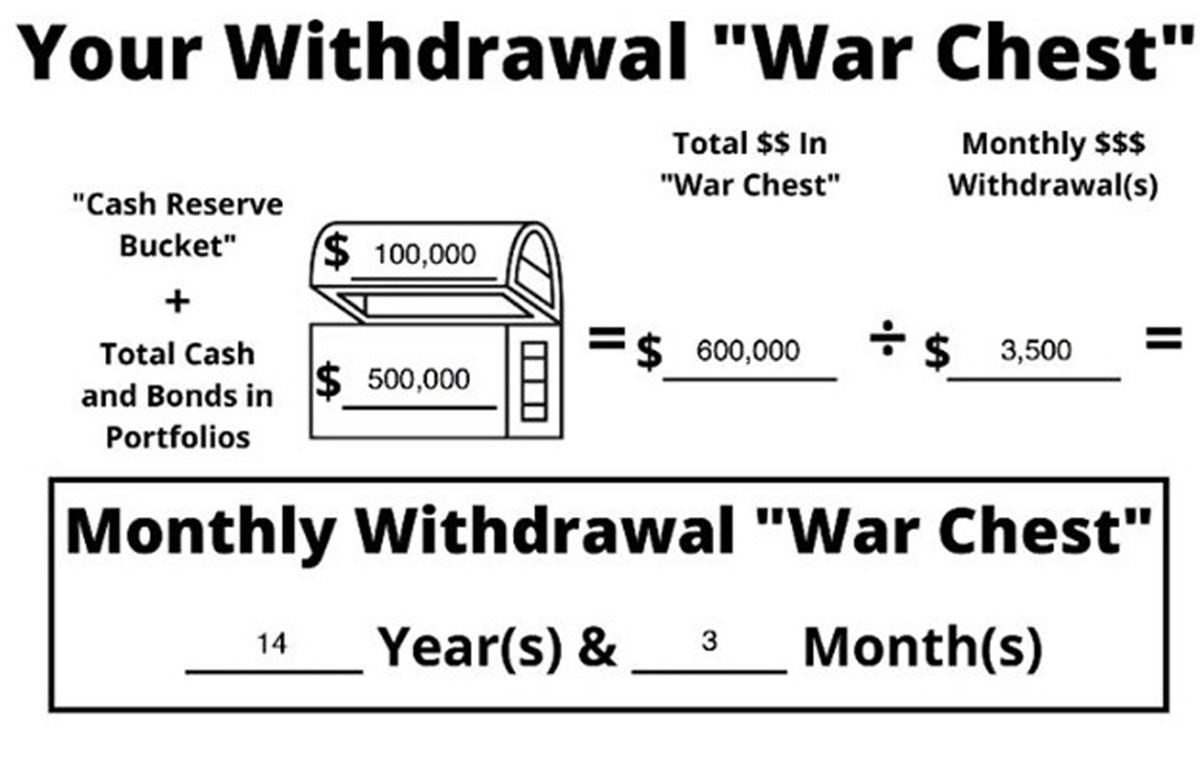Are You Going to Be OK in Retirement? 1 Easy Calculation Can Provide the Answer
Running out of money in retirement is a common fear, but knowing you have enough cash on hand to get through a severe stock market downturn can help. It’s a figure I call your “Withdrawal War Chest,” and it’s simple to calculate.


The stock market goes through recurring cycles that look to us like the four seasons. Fear is rarely apparent in spring or summer and barely palpable even in the fall. However, the “winter” portion of a stock market cycle is typically the harbinger of emotion-filled missteps by many investors.
“Am I going to be living under a bridge?” This is a “winter” question that I have often been asked over the past four decades, especially by prospective clients without a plan, even those with millions of investable dollars. This is because much of the “top of mind” space in our brain is allocated to thinking about our basic needs, including food, clothing, shelter, health care, transportation and education. When the stock market goes down, the reptilian, self-preservation portion of people’s brains often takes over, and they worry first and foremost about funding their basic needs.
The next and most important “winter” question I get asked is, “Am I going to be OK?” This is often due to a misperception that “something seems to be different this time.” Different in a potentially very bad way, more unusual than anything we’ve ever seen, and as a result, I may not be able to live and enjoy anywhere near the quality of life I had planned throughout retirement.
From just $107.88 $24.99 for Kiplinger Personal Finance
Become a smarter, better informed investor. Subscribe from just $107.88 $24.99, plus get up to 4 Special Issues

Sign up for Kiplinger’s Free Newsletters
Profit and prosper with the best of expert advice on investing, taxes, retirement, personal finance and more - straight to your e-mail.
Profit and prosper with the best of expert advice - straight to your e-mail.
At our firm, we have created a tool to provide clients with peace of mind showing them approximately how long they will be “OK.” I call this the “Withdrawal War Chest.” A war chest has historically been defined as a fund accumulated to finance a war, and recently, has expanded its meaning to a fund earmarked for a specific, challenging purpose. There are few financial endeavors more challenging than planning for retirement. Luckily, knowing your Withdrawal War Chest makes such planning much less stressful.
So how do you figure out your Withdrawal War Chest? Here’s our simple process:
- Add your total cash reserves AND total cash and bonds in your portfolios to get your War Chest.
- Divide your total War Chest by your monthly retirement withdrawal.
- That’s it.
This calculation provides an estimated time frame in which your War Chest (cash and bonds) alone could support your cash flow needs without withdrawing or selling a single penny from equities (stocks). To show you what that calculation could look like, let’s look at a hypothetical couple — John and Jane — who have a nice cash cushion saved up.

While the War Chest calculation is a simple one, its impact is tremendous. Your monthly Withdrawal War Chest is not only protection, but most importantly, peace of mind. Take John and Jane from our example above. They have 14 years and 3 months’ worth of withdrawals that is completely independent of the stock market. They don’t have to worry about it bouncing up, down or sideways. It’s just a quick snapshot, but it’s one that offers people confidence, because if the stock market goes through an extended “winter,” people are sure they can withstand it by not being forced to sell low.
The majority of people who liquidate most or all of their stocks while going through stock market downturns don’t have a plan and give in to fear. These types of emotional decisions often result in financial losses that are never recovered. This is not something you want to say when reflecting back on your life savings. While there is no magic wand to wave to take the emotions out of a decision, having a plan in place and knowing your Withdrawal War Chest can make those winter periods much less stressful.
Our typical retirement monthly Withdrawal War Chest has 10+ years of withdrawals. That being said, each individual household and family has their own unique needs. However, if you have a plan and know your Withdrawal War Chest, you can take a lot of anxiety out of investing and planning throughout retirement.
This information is prepared by DiNuzzo Wealth Management, and all opinions are the judgment of author P.J. DiNuzzo, as of the date of publication and could be subject to change. This material is provided for educational purposes only and readers should not rely on the content as the only basis for investment or retirement decisions or advice. Always consult with your personal financial adviser and tax adviser before making any financial decisions.
Profit and prosper with the best of Kiplinger's advice on investing, taxes, retirement, personal finance and much more. Delivered daily. Enter your email in the box and click Sign Me Up.

P.J. DiNuzzo, CFA, PFS, AIF, MBA, MSTX, is the founder, president and chief investment officer for DiNuzzo Private Wealth Inc./DiNuzzo Wealth Management in Beaver, PA. The firm has been helping pre-retirees and retirees make smart money and best-life choices for 31 years. P.J. is also the author of the book "The Seven Keys to Investing Success."
-
 Fed's Rate Cuts Could Have Impacts You Might Not Anticipate
Fed's Rate Cuts Could Have Impacts You Might Not AnticipateUnderstanding how lower interest rates could impact your wallet can help you determine the right financial moves to make.
-
 Past Performance Is Not Indicative of Your Adviser's Expertise
Past Performance Is Not Indicative of Your Adviser's ExpertiseMany people find a financial adviser by searching online or asking for referrals from friends or family. This can actually end up costing you big-time.
-
 I'm want to give my 3 grandkids $5K each for Christmas.
I'm want to give my 3 grandkids $5K each for Christmas.You're comfortably retired and want to give your grandkids a big Christmas check, but their parents are worried they might spend it all. We ask the pros for help.
-
 Past Performance Is Not Indicative of Your Financial Adviser's Expertise
Past Performance Is Not Indicative of Your Financial Adviser's ExpertiseMany people find a financial adviser by searching online or asking for referrals from friends or family. This can actually end up costing you big-time.
-
 I'm a Financial Planner: If You're Not Doing Roth Conversions, You Need to Read This
I'm a Financial Planner: If You're Not Doing Roth Conversions, You Need to Read ThisRoth conversions and other Roth strategies can be complex, but don't dismiss these tax planning tools outright. They could really work for you and your heirs.
-
 Could Traditional Retirement Expectations Be Killing Us? A Retirement Psychologist Makes the Case
Could Traditional Retirement Expectations Be Killing Us? A Retirement Psychologist Makes the CaseA retirement psychologist makes the case: A fulfilling retirement begins with a blueprint for living, rather than simply the accumulation of a large nest egg.
-
 I'm a Financial Adviser: This Is How You Can Adapt to Social Security Uncertainty
I'm a Financial Adviser: This Is How You Can Adapt to Social Security UncertaintyRather than letting the unknowns make you anxious, focus on building a flexible income strategy that can adapt to possible future Social Security changes.
-
 I'm a Financial Planner for Millionaires: Here's How to Give Your Kids Cash Gifts Without Triggering IRS Paperwork
I'm a Financial Planner for Millionaires: Here's How to Give Your Kids Cash Gifts Without Triggering IRS PaperworkMost people can gift large sums without paying tax or filing a return, especially by structuring gifts across two tax years or splitting gifts with a spouse.
-
 'Boomer Candy' Investments Might Seem Sweet, But They Can Have a Sour Aftertaste
'Boomer Candy' Investments Might Seem Sweet, But They Can Have a Sour AftertasteProducts such as index annuities, structured notes and buffered ETFs might seem appealing, but sometimes they can rob you of flexibility and trap your capital.
-
 Quick Question: Are You Planning for a 20-Year Retirement or a 30-Year Retirement?
Quick Question: Are You Planning for a 20-Year Retirement or a 30-Year Retirement?You probably should be planning for a much longer retirement than you are. To avoid running out of retirement savings, you really need to make a plan.
-
 Don't Get Caught by the Medicare Tax Torpedo: A Retirement Expert's Tips to Steer Clear
Don't Get Caught by the Medicare Tax Torpedo: A Retirement Expert's Tips to Steer ClearBetter beware, because if you go even $1 over an important income threshold, your Medicare premiums could rise exponentially due to IRMAA surcharges.